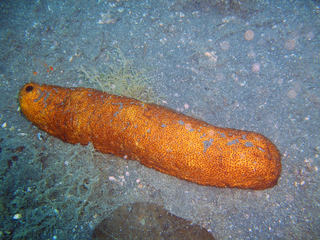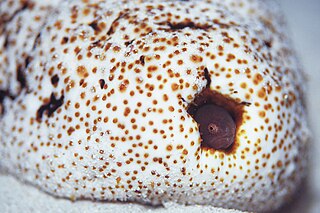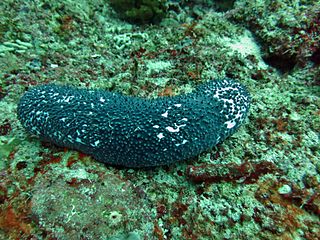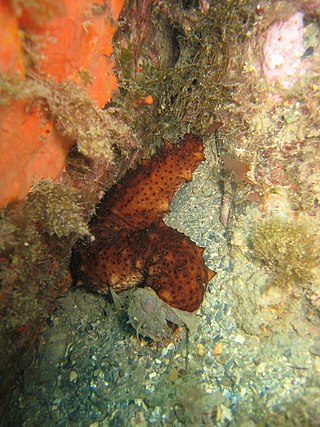
The California sea cucumber, also known as the giant California sea cucumber, is a sea cucumber that can be found from the Gulf of Alaska to Baja California. It is found from the low intertidal zone to a depth of 250 m (820 ft). They are most abundant in areas with moderate current with cobbles, boulders or bedrock. They are artisanally fished.

Holothuriida is an order of sea cucumbers. Taxa within the order Holothuriida were previously classified in the order Aspidochirotida, which was determined to be polyphyletic in 2017. Some taxa were also reclassified into the clades Synallactida and Persiculida.

Isostichopus fuscus, commonly known as the brown sea cucumber, is a species of sea cucumber in the family Stichopodidae native to the eastern Pacific. It was first described to science by German biologist Hubert Ludwig in 1875.

Holothuria atra, commonly known as the black sea cucumber or lollyfish, is a species of marine invertebrate in the family Holothuriidae. It was placed in the subgenus Halodeima by Pearson in 1914, making its full scientific name Holothuria (Halodeima) atra. It is the type species of the subgenus.

Bohadschia argus, the leopard sea cucumber, leopardfish, or tigerfish, is a species of sea cucumber in the family Holothuriidae. It is native to the tropical Western Indo-Pacific region.

Bohadschia is a genus of sea cucumbers in the family Holothuriidae. They are among the largest, most common, and conspicuous sea cucumbers on coral reefs. They have large, loaf-like bodies that are often strikingly colored.

Bohadschia marmorata, commonly known as the brown sandfish or chalky cucumber, is a species of sea cucumber in the family Holothuriidae. It lives on the seabed in shallow waters in the Indo-Pacific region.

Lissocarcinus orbicularis, common names sea cucumber crab, red-spotted white crab, and harlequin crab is a species of crab in the family Portunidae. This species gains one of its names from its close-knit relationship with holothuroids, the sea cucumbers. L. orbicularis should not be confused with L. laevis, a similar species of swimming crab, or Camposcia retusa, both of which are also commonly referred to as the harlequin crab. L. orbicularis displays numerous morphological and social adaptations for feeding and has a large distribution throughout the Indo-West Pacific.

The pinhead pearlfish, Encheliophis boraborensis, is a species of slender, ray-finned fish in the family Carapidae found in the tropical Indo-Pacific Ocean; it normally lives inside the body cavity of a sea cucumber such as the pineapple sea cucumber or the leopard sea cucumber.
The silver pearlfish, Encheliophis homei, is a species of eel-like fish in the family Carapidae. This pearlfish lives inside the coelom of sea cucumbers such as Bohadschia argus, Thelenota ananas , and Stichopus chloronotus. It is native to tropical and subtropical parts of the Indo-Pacific Ocean.

Astichopus is a monotypic genus of sea cucumbers, the only species in the genus being Astichopus multifidus. It is commonly known as the furry sea cucumber or the fissured sea cucumber and is native to the Caribbean Sea.

Stichopus herrmanni, or Herrmann's sea cucumber, is a species of holothuroidean echinoderm in the family Stichopodidae. It is found in the tropical, western Indo-Pacific Ocean, at depths down to 20 m (66 ft). This and several other species are known as curryfish and are harvested commercially; it is called gama in Indonesia.

Actinopyga caerulea, the blue sea cucumber, is a species of sea cucumber in the family Holothuriidae. Named for its unique blue coloration, this species can be found along the continental shelf of the tropical Western Indo-Pacific region, at depths between 12 and 45 m. It is a commercially important species, and is harvested for food along its range.
Actinopyga agassizii, commonly known as the five-toothed sea cucumber or West Indian sea cucumber, is a species of sea cucumber in the family Holothuriidae. It was first described by German zoologist Emil Selenka in 1867. It is native to the Western Atlantic region, including the Gulf of Mexico and the Caribbean Sea, and is harvested for food.
The Dr. K.K. Mohammed Koya Sea Cucumber Conservation Reserve is a marine protected area located off the coast of the Indian union territory of Lakshadweep, approximately 50 km (31 mi) northwest of the island of Bitra. Formally established by Indian authorities on February 27th, 2020, the reserve covers 239 km2 (92 sq mi) of the Arabian Sea, including parts of the Byramgore (Cheriyapani) Reef, and is the world's first conservation area specifically dedicated to the protection of sea cucumbers.

Holothuria stellati, also known as the Brown sea cucumber,is a species of sea cucumber in the family Holothuriidae. First described by Delle Chiaje in 1824. There are two accepted subspecies, Holothuria stellatidakarensis and Holothuria stellati mammata, though there is still debate on whether or not they are separate species.
Holothuria (Selenkothuria) glaberrima, also known as the brown rock sea cucumber, is a species of sea cucumber in the genus Holothuria, subgenus Selenkothuria. The cucumber is distributed in the Western Atlantic Ocean, the Caribbean Sea, and the Gulf of Mexico. The species is found at a depth of 0–42 meters.

Holothuria (Thymiosycia) impatiens, commonly known as the impatient sea cucumber or bottleneck sea cucumber, is a species of sea cucumber in the genus Holothuria, subgenus Thymiosycia.

Bohadschia ocellata, also known as the polka-dotted sea cucumber, is a species of sea cucumber in the family Holothuriidae. It is native to the tropical Western Indo-Pacific region.















